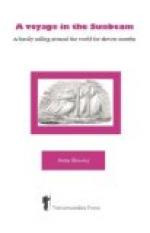One of the heads of the establishment, a great friend of Madame Cousino’s, was unfortunately very ill, and as she was nursing him, she could not come out to see us; but she kindly gave orders to her gardener to send some cut flowers and some ferns on board the yacht, to decorate the saloon; and as she was unable to invite us to luncheon at the big house, she sent some champagne and refreshments down to the Casa de la Administracion, where we were most hospitably entertained. She has had the latter place comfortably fitted up for the use of the principal employes on the works, and has provided it with a billiard-table, a very fair library, and several spare bed-rooms for the accommodation of visitors.
After luncheon we went to see the copper-smelting works, which were very interesting. The manager walked through with us, and explained the processes very clearly. He could tell at once, on taking up a piece of rough ore, fresh from the mine, what percentage of copper or iron it contained, the amount varying from ten to seventy-five per cent, of the gross weight. The furnaces are kept burning night and day, and are worked by three gangs of men; and the quantity of copper produced annually is enormous. In fact, three parts of the copper used in Europe comes from here. The ore is brought from various parts of Chili and Peru, generally in Madame Cousino’s ships; and coal is found in such abundance, and so near the surface, that the operation of smelting is a profitable one. Our afternoon, spent amid smoke, and heat, and dirt, and half-naked workmen, manipulating with dexterous skill the glowing streams of molten ore, was a great contrast to our morning ramble.
Having seen the works, and received a curious and interesting collection of copper ore, as a remembrance of our visit, we started in a little car, lined with crimson cloth, and drawn by a locomotive, to visit the various coal-mines. First we went through the park, and then along a valley near the sea, full of wild flowers and ferns, and trees festooned with ‘copigue,’ the Chilian name for a creeper which is a speciality of this country, and which imparts a character of its own to the landscape during the month of May, when its wreaths of scarlet, cherry, or pink flowers are in full bloom. We went to the mouths of three coal-pits, and looked down into their grimy depths, but did not descend, as it would have occupied too much time. They are mostly about 1,000 yards in depth, and extend for some distance under the sea.
We next visited a point of land whence we could see an island which closely resembles St. Michael’s Mount. It is quite uninhabited, except by a few wild goats and rabbits. The sea-shore is lined with trees to the water’s edge, and there are many bold rocks and fine white sandy caves in different parts of it. Some boats were drawn up high and dry on the beach, along which several picturesque-looking groups of shell-fish collectors were scattered. The mussels that are found here are enormous—from five to eight inches in length—and they, together with cockles and limpets, form a staple article of food.




